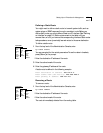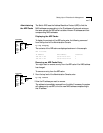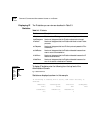
3-8 CHAPTER 3: CONFIGURING MANAGEMENT ACCESS TO THE SYSTEM
■ Gateway IP Address
This address tells the router how to forward packets whose destination
address matches the route’s IP address and subnet mask. The system
forwards such packets to the indicated gateway.
■ Status
The status of the route provides the information described in Table 3-2.
In addition to the routes to specific destinations, the routing table can
contain an additional entry, called the default route. The system uses the
default route to forward packets that do not match any other routing table
entry. You might want to use a default route in place of routes to numerous
destinations that all have the same gateway IP address.
Displaying the Routing Table
You can display the routing table for the system to determine which routes
are configured and if they are operating.
To display the contents of the routing table, enter the following from the
top level of the Administration Console:
ip route display
In the following example, routes for the Switch 2200 are displayed. The
configuration of RIP is indicated in the status display.
Destination Subnet mask Metric Gateway Status
158.101.4.0 255.255.255.0 2 158.101.2.8 Static
158.101.3.0 255.255.255.0 2 158.101.1.2 Learned(RIP)
158.101.2.0 255.255.255. 1 -- Direct
158.101.1.0 255.255.255.0 1 -- Direct
Default Route -- 5 158.101.1.2 Learned (RIP)
Table 3-2 Route Status
Status Description
Direct Route to a directly connected network
Static Route was statically configured
Learned Route was learned using indicated protocol
Timing out Route was learned but is partially timed out
Timed out Route has timed out and is no longer valid
Top-Level Menu
system
ethernet
bridge
➧ip
snmp
analyzer
script
logout
interface
➧route
arp
rip
ping
statistics
➧display
static
remove
flush
default
noDefault


















